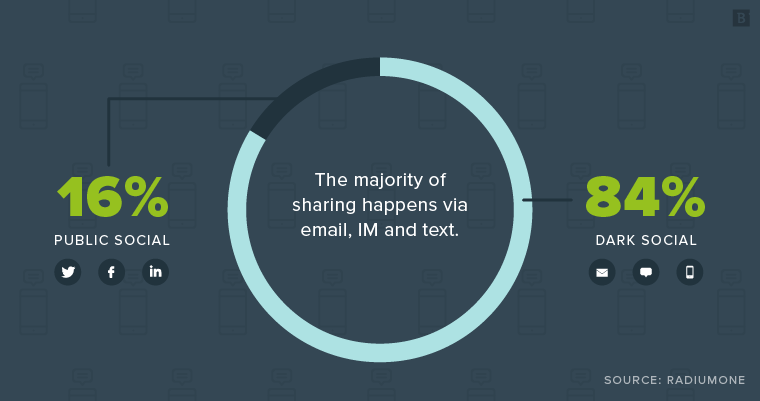Dark social sounds scary, but it has a bright side.
Imagine this:
- You got excited by an industry report and you shared the link to your team via email.
- Your college friends are planning a reunion and exchanged the websites of possible event venues via private group chat on Facebook Messenger.
- Aunt Sally wants you to check out a recipe posted online, sending the page URL to your phone via SMS text messaging.
- You clicked a linked image displayed on a secure (HTTPS) webpage that leads you to an unsecured (HTTP) online location.
In all these cases, it’s nearly impossible to track the source of web traffic due to the privacy restrictions of the specific channels used by the referring person.
The inability to pinpoint the actual source of link referrals constitutes a huge challenge for digital marketers. Not only does it screw with your analytics, it also leads to inaccurate tracking of marketing funnels and erodes the effectiveness of lead generation strategies.
This surprising phenomenon has an ominous name: dark social.
For many years, “dark social” has eluded web tracking software, scrambling the minds of web marketers professionals and making it much harder for businesses to measure marketing ROI.
And those aren’t even the worst aspects of the problem.
How many times have you shared a URL using your email or the direct messaging service of social networks such as Facebook, LinkedIn, and Twitter? Quite a lot, I presume.
In fact, millions of people do it everyday. That’s why dark social accounts for around 84% of onsite shares, easily beating Facebook (9%) and other social networks (7%) as a referral channel, according to RadiumOne.

Clearly, the vast majority of sharing and referrals are facilitated through email, direct messaging, and SMS text.
That means quite a lot of the online activities digital marketers should be observing are trapped inside a black box that offers zero visibility. In a sense, businesses are practically firing blind when it comes to mapping out their online campaigns.
Some possible “quick fix” solutions:
The key takeaway is that dark social presents a huge opportunity cost for businesses, but thanks to advancements in technology, there are a few slick ways to get around the problem.
Given the new technologies available to web marketers, I believe businesses should consider tracking content consumption metrics in addition to lead sources when making marketing decisions.
Smart businesses, for example, already use workarounds such as UTMs and shortened links for that purpose. Meanwhile, marketers can also try leveraging Cloud VoIP solutions that use virtual phone numbers as tracking mechanisms.
In a nutshell, this solution assigns unique IP-based phone numbers for each marketing campaign done over specific channels such as web, mobile, TV and email. Using native analytics, the “performance” of these phone numbers can be measured with accuracy.
Among other valuable metrics, the number of inbound calls and the call duration associated with each designated virtual number (and specific campaign) can be monitored. More on these exciting tactics later.
The problem with messaging apps
Unlike public social sharing activities such as likes, posts, upvotes, comments and retweets, dark social interactions are hidden from web tracking tools.
Messaging apps (such as WhatsApp, WeChat, Viber, Messenger and Snapchat), SMS text, email and the native direct messaging services of social networks (such as those of LinkedIn and Twitter) are the common channels used in dark social.
Online traffic driven from dark social does not contain referrer information nor other metadata such as UTM parameters that could indicate the source of a click. Any clicks to links or URLs that are exchanged in dark social are often erroneously labeled as “direct traffic.”
However, no one really bothers to know, much less type, all the letters and symbols of URLs (especially lengthy and complex ones), so it’s safe to assume that a huge proportion of “direct traffic” are actually clicked-on links that are shared via dark social.
Millennials and Gen Z’ers — who will comprise the bulk of the consumer and B2B market for all services and products in the foreseeable future — overwhelmingly prefer to use messaging apps to communicate with one another.
Meanwhile, privacy laws such as GDPR (General Data Protection Regulation) and CCPA (California Consumer Privacy Act) all but ensure that dark social environments will persist and even expand in the future.
10 Real-World Examples: Getting Around “Dark Social”
Dark social is challenging but it can be navigated. The first few steps to fighting back against dark social are pretty simple:
- Accept that dark social exists.
- Understand the channels and situations that make it possible.
- Optimize its insight-generation potential.
Here are 10 tactics and best practices to consider:
- Upgrade your source attribution efforts using tools and practices that improve the accuracy of your web traffic analytics and forecasting. Doing so will:
- Strengthen the rationale for your marketing spend (you identify the best channels and content to put your money on).
- Deliver optimum impact (you have better, deeper and more accurate insight about your audience).
- Leverage dark social metrics. SocialMediaToday recommends that you configure Google Analytics by setting up a “Dark Social” segment to filter traffic that’s likely driven from dark social. Visitors who downloaded a landing page via “direct traffic” but who did not previously visit the homepage are likely to have come via dark social, for example.
- Use dark social tracking tools such as:
- AddThis: A suite of free website tools that include widgets for social sharing on networks such as Facebook, LinkedIn and Twitter. The suite comes with an analytics dashboard.
- ShareThis: A widget that enables users to share any content over multiple channels including email, social networks and messaging apps. The service comes with a customization menu and tracking capabilities for dark social.
- Po.st: A social sharing platform that comes with a link shortener, copy-&-share tracker for dark social and comprehensive analytics.
- GetSocial: A content sharing and analytics platform that enables marketers to measure content performance and amplify the impact of their popular content.
- Optimize and align the use of url shorteners such as Bitly and Ow.ly for dark social. Using unique shortened links per channel or content makes tracking user engagement easier and more accurate.
- Deploy a UTM strategy to your links to track web traffic. Basic, but it helps.
- Enhance your traffic analytics by tracking content consumption metrics in addition to metrics that identify lead sources. By measuring the performance (virality) of each of your content assets, you gain valuable insight on which specific content to use in different scenarios. By analyzing content consumption metrics, you can further amplify the impact of the specific content that most resonates with your audience or target buyers.
- Develop engagement playbooks, campaigns, and specialized content for messaging apps, email, sms texting and direct messaging services. For example, you can create personalized content for specific customers based on their dark social activities (i.e., what types of content they consume and share on dark social channels).
- Use chatbots for your website, mobile app and messaging apps such as Messenger and Slack whenever applicable. This not only helps augment and enhance customer service but also helps 1) build brand presence in dark social, 2) track shares, and 3) monitor customer needs and behavior.
- Form messaging teams to build and manage communities for your brand on dark social channels when resources allow for it. You can tie this up with the previous item.
- Adopt full-featured VoIP solutions that help generate business insight and enable the creation of special, trackable numbers for specific marketing campaigns. In addition to helping attribution efforts, toll-free virtual numbers enable digital marketers to track audience response, optimize the impact of their messaging, and drive positive business outcomes. VoIP solutions can also improve lead generation efforts by tracking which designated numbers, time or location produce the most number of qualified leads. Such valuable intel can be used to adjust sales playbooks and scripts, providing competitive advantage. Because IP-based phone services leverage real-world data, they provide more visibility to customer engagement and stronger uplift to revenue performance.
Conclusion:
Dark social will remain a vast channel and market of opportunity for the foreseeable future because of two primary reasons:
- Millennials and Gen Z’ers (who will soon account for the largest proportion of consumers and B2B buyers) prefer the use of messaging apps, email and direct messaging services.
- There’s a global imperative for consumer privacy and data protection, with compliance regimes such as GDPR and CCPA already in place.
Dark social poses daunting challenges but it also holds much promise. The key is to embrace this reality, gather insight whenever possible and use such insight to benefit your company.
There are tools and methods that can help organizations navigate the muddled terrain of dark social. You can use specialized dark social software and VoIP solutions, for example. The question is, are you already using some of them?





